编者按:作者世友居士(Dhammachari Lokamitra,原名Mr. Goody Jeremy,1947- )生于英国伦敦,师从僧护居士(Dhammachari Sangharashita,原名Mr. Dennis Lingwood,1925- ),1977年参访印度,从此继承印度首任司法部长、印度宪法起草者安倍卡博士的遗志,以“难行能行”的菩萨道精神,在印度持续帮助达利特(俗称贱民)阶层,领导印度佛教复兴;在龙树菩萨的家乡——印度龙城,创办了龙树学院,开展多专业教育、慈善、公益等工作,迄今40余年,成就卓著。(印度贱民阶层系四种姓之外的社会底层,有2.3亿人口,承担着印度最底层的劳动工作)为便于中文读者阅读,英文原文附于每段中译文之后。照片由世友居士、南怀瑾学术研究会提供,编辑插图。文后附录世友居士文章《龙树学院于印度佛教复兴中的重大意义》。
本文源自南怀瑾学术研究会、南怀瑾文教基金会,作者授权发表。转载请注明出处。
南怀瑾大师的启示
Inspiration from Master Nan
作者:(英国)Dhammachari Lokamitra(世友居士)
中文译者:(新加坡)刘宜霖
我1990年代初期经常走访台湾,时常安单于台北十方禅林,寝室就在禅堂后面的一个小房间。我每次走向房间的时候,都会经过一面墙,墙上挂着一张南大师闭目禅坐的肖相。我暗想这应该是一位了不起的大师级人物,但未曾想过此生竟有机遇亲自拜见他老人家。我何其有幸,能于大师晚年两次拜会。这两次的交谈,的确是丰富了我的人生,让世友时刻铭记,内心无限感念。进入正题之前,我必须略微介绍一下我从事的工作,以及与太湖大学堂结缘的经过。
On my visits to Taiwan In the early 1990’s I used to stay at the Ten Directions Chan Temple (or Buddhist Centre) when in Taipei. I stayed in a small room at the back of the meditation hall. Every time I went to the room I passed a large photo of Master Nan in meditation posture, on the wall. I realised he must be a very great Master indeed, but never dreamt it would be possible for me to communicate with him personally. I did however get the opportunity to meet him twice towards the end of his life, those meetings adding an indescribable richness to my life which I remember every day with enormous gratitude. Before writing about that, I should give some background to the work I am involved in that brought me to the Taihu Great Learning Centre.
世友出生于英国,自1977年以来一直生活在印度,活动于数百万所谓“贱民”(现俗称“达利特”)的新皈依佛弟子当中。第一次的皈依大典发生在1956年,安贝卡博士引领了50万追随者参与三皈依。尽管出身贱民,其卑贱的身份为他带来了巨大的不利影响,但他却透过自身的聪慧睿智与精勤努力,成为上世纪受过最高等教育的印度人。此后,更成为印度独立后的第一位司法部长,兼任新宪法起草委员会主席,期间拟定了许多改善社会以及有利贱民的条例。然而,在他生命接近尾声之时,他相信唯有透过佛教,印度方能经由和平的途径,转型为真正平等的社会。虽然他皈依佛教仅数周便撒手人寰,但那次皈依大典的效应却持续至今,新皈依佛弟子的数量目前仍在大幅增长。据估计,现阶段新皈依佛弟子的数量已经超过五千万人数。
I was born in UK but have lived in India since 1977, living and working amongst the millions of so-called Untouchables (now commonly known as “Dalits”) who have converted to Buddhism. The first conversion of 500,000 people was led by Dr. B. R. Ambedkar in 1956. He was born an Untouchable with all the overwhelming disadvantages that that status brought, but through his own intelligence and hard work, became one of the most highly educated Indians of the last century. He brought about many legal and social changes benefitting the Untouchables, becoming the first law minister of independent India, and the chairman of the drafting committee for the new constitution. However at the end of his life he believed that only through Buddhism could India be transformed into an egalitarian society through peaceful means. Although he died just a few weeks after becoming Buddhist, the conversions have continued at an increasingly fast pace, some estimating the number of newly converted Buddhists at over 50 million.
大约1977年,我于马哈拉施特拉邦西部地区积极传扬佛教、建立佛教教学设施以及推动相关计划,而当时的皈依也都集中于此。然而在过去25年当中,皈依已经蔓延至印度的每一个角落。这些新皈依的佛弟子绝大多数家境贫穷,备受社会剥夺。而且令人惋惜的是,能够为这些新佛弟子开示佛法的老师极少,佛教界也鲜少对他们伸出援手。若想凭一己之力深入印度各个角落去弘法,的确是件不可能的任务,但是我们可以接引年轻人来接受培训。因此15年前,我们开始于中印度龙城(译音:那格浦尔)建立龙树学院,开始培训年轻人基础佛教教义和禅修(以观呼吸和慈心禅为主)。我们的课程包括为期八个月的住宿培训,以及为期三年,由那格浦尔大学颁发文凭的佛学学士学位。学生在学期间,亦学习如何将佛法落实到社会工作上。从2002年至今,龙树学院住宿培训的毕业生已经超过1200位,遍及全印度29州的25州。这支学生队伍,目前已组成了全印度的“法行者”网络。
At first these conversions were concentrated in the western state of Maharashtra, where I taught basic Buddhism and helped to develop Buddhist teaching facilities and social projects from 1977. In the last 25 years the conversions have spread to every corner of India, although most are extremely poor and socially deprived. Unfortunately there are very few trained Buddhist teachers in India and there has been very little help forthcoming from the Buddhist world. It was impossible to develop Dharma teaching activities all over India, but we could bring people to us for training. 15 years ago we developed the Nagarjuna Institute, in Nagpur, central India, to train young people in basic Buddhist teachings and meditation practices (the anapana sati and the metta bhavana). We conduct an eight month residential training and also a three year residential BA course in Buddhist Studies as part of Nagpur University. The students also learn about how to combine Dharma practice with social work. Since 2002 almost 1,200 young people from 25 of the 29 Indian States have participated in the residential training programme and make up an all-India network of Dharma practitioners.
我们希冀给予学生的精神象征,就坐落在校园的中心——一座33英尺(10米)高的铜铸弘化大佛,身呈往前行走之状、手持施无畏印,底部是20英尺高的基座。佛法的实践不仅意味着自身的改变,更意味着世界的改变,二者必须相辅相成。我们不可能将正法占为己有,而必须效仿佛陀,积极地将正法传达给他人。这尊释迦佛像自2009年落成之后,就吸引了成千上万的善信到此朝圣。此塑像的雕塑家詹文魁先生于2005年拜访龙树学院之后,便发愿要担此重任,将此计划引介给南大师和他的弟子,才让这尊庄严、独特的佛像矗立校园中央。
The spirit we try and inculcate in the students is beautifully and dramatically symbolised at the centre of the campus by a magnificent 33 foot high brass statue of the Buddha Walking in Fearless (Abhaya) Mudra, and raised on a 20 foot mound. Dharma practice implies transformation not only of oneself but also of the world; the two have to go together. We cannot just keep the Dharma to ourselves; like the Buddha we have to be active in communicating it to others. Since the day it was erected in 2009 it has become an icon of Buddhism in modern India, attracting and inspiring faith in hundreds of thousands of pilgrims. The sculptor, Master Wen Kwei Chan, had visited us in 2005 when he made a great vow to undertake this work. Wen Kwei introduced the project to Master Nan and some of his disciples who helped to make this unique and beautiful image possible.
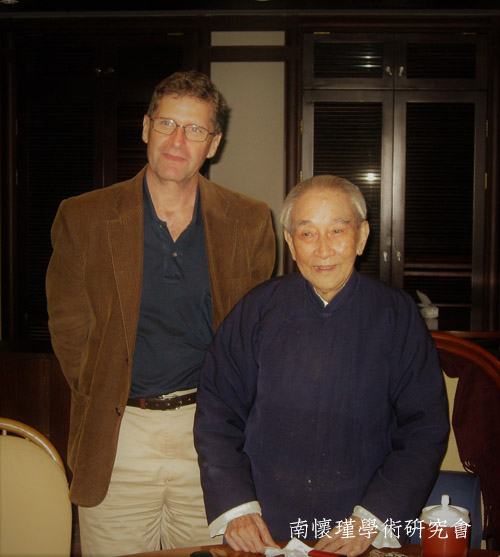
我于2008年11月会晤南大师,向他汇报印度佛教复兴的背景,同时感谢他大力支持筹建佛像的事宜。那是我第一次拜访中国。就在那个湿湿冷冷的黄昏,我从浦东机场直接来到了太湖大学堂。我曾于台湾的许多道场安单,因此猜想太湖大学堂也大致如此,但事实却让我吃惊。我当天作了简报,但南大师显然并不满意,因此我只能够草草结束了演讲。之后,在茶叙之间,南大师详细阐述了社会的变迁。他认为想要根除种姓制度,其重要途径不外乎权力与金钱。他接着说,若想消除种姓制度,首先就必须以经济变革作为后盾。他认为印度当前需要的佛教并非过去传统那种柔性的佛教,而是一种具备大威势力的佛教。接着还谈到我们的学生必须了解“业”(因缘条件)的运作。然后又随顺弟子的提问讲解了念佛法门与禅修的结合。他认为念佛并非宗教仪式,它是超越宗教的,“南无阿弥陀佛”意味着礼敬大智慧的无量光明。另外,他还强调印度佛弟子学习中文的前瞻性,并承诺支持龙树学院的学生学习中文。他最后希望印度某些学生能因此走入汉译佛典,从博大精深的中国佛教传统受惠,同时作为联系中印佛弟子的桥梁。龙树学院亦藉此因缘,现阶段已经有好几位学生正在学习中文。想要培养出真正能够深入中国佛教经藏的学者,相信还需很久,但我们会朝这个目标前进。那次的会晤,南大师在我告辞时特地送行,给了我满满的祝福与鼓励。
In November 2008 I went to meet Master Nan to talk about the background of the work and thank him for his help in supporting the Walking Buddha. It was my first visit to China and I was taken straight from Pudong Airport to the Taihu Great Learning Centre on a cold, wet evening. I had visited and stayed in many Buddhist temples in Taiwan and assumed the Taihu Centre would be similar, but I was in for a surprise. I made my presentation but curtailed it prematurely as Master Nan did not seem satisfied. Afterwards, while drinking tea, Master Nan talked at length about social change. He said that the sort of changes required to eradicate untouchability could only be achieved through means of power and money. He went on to talk about the need for economic change to underpin the eradication of untouchability. He said that the sort of Buddhism required was not the soft Buddhism of the past but a strong, powerful Buddhism. He talked about the need for our students to understand karma (in the sense of conditionality) and the importance of Amitabha chanting combined with meditation. He said chanting Namo Amitabha Buddha was not a religious practice, it went beyond religion, meaning salutation to the unlimited light of great wisdom. He emphasised the opportunities that could develop if Buddhists in India learn Chinese, and said he would support the Chinese learning programme for the students of Nagarjuna Institute, eventually hoping that some could study Chinese Buddhist texts in Chinese. In this way he hoped that Indian Buddhists could benefit from the great wealth of the Chinese Buddhist tradition, and that a link would be forged between Indian and Chinese Buddhists. As a result of that quite a few students have now learnt basic Chinese language. It will be some time before we have some real scholars but we are working towards it gradually. The next morning Master Nan saw me before leaving, showering me with encouragement and blessings.
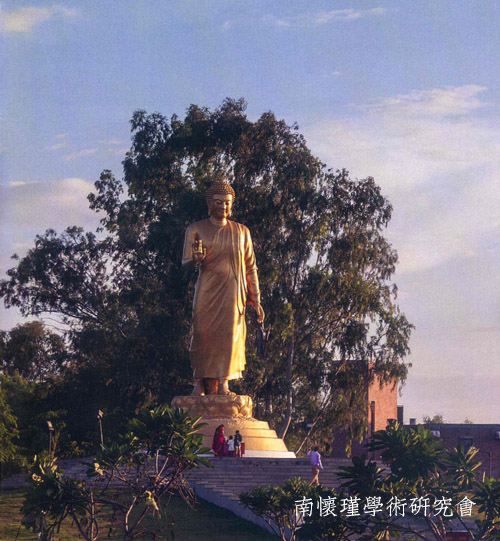
2011年5月份,我再访太湖大学堂,特为“行禅中的佛陀”塑像落成等事向南大师报告并表达我与同事们的感激之情。这次让我大为宽慰的是,南大师对我的简报相当满意。我报告完毕,他站起来告诉所有在场的弟子必须支持印度佛教之复兴,同时自己还承诺予以巨额捐款。当我回到印度之后,收到的金额竟比他早先的承诺多出了许多,让我们有余额建造一栋漂亮的建筑物作为培训之用。南大师问了有关印度的现况。大师的提问,让我惊叹于其学识之渊博。他说佛陀是第一位强调人类平等与众生平等的人,并提出佛教是唯一一个不涉及“主宰者”的宗教,因此并未营造一个不平等的制度。他说,在印度,我们必须透过三十七道品以及十波罗蜜了知法义。他强调,达利特因其特殊的因缘,得以透过正法而成长。在详细阐述了四念住之后,又把观点带回到平等观。他强调我们必须因地制宜,根据印度当地的实况引介佛法。这一点真是说到了世友心坎里,让我深受感动。这位长者,竟然仅于一顿晚餐的时间,就深入浅出地把佛法的奥义阐释得清清楚楚。
I returned to the Taihu Great Learning Centre in May 2011 to express the enormous gratitude my colleagues and I felt for his contribution to the Walking Buddha. This time to my great relief Master Nan seemed extremely happy with the presentation I made. When he rose to speak he told his disciples present they must help the work in India, he himself promising a very large donation (when I arrived back in India I found we had received much, much more than he had declared – we were able to construct a beautiful building for training with it). He asked questions about the situation in India, obviously extremely knowledgeable. He said the Buddha was the first person to emphasise equality between human beings and also all sentient beings. He talked of Buddhism as the only religion that did not involve a commander, and so establish a system of inequality. He said that in India we should approach the Dharma through the 37 Bodhipakshas, or wings of Enlightenment, as well as the Paramitas. He emphasised that Dalits have a special opportunity to grow through the Dharma due to their experience. Talking at length on the four foundations of mindfulness, he continually brought the point around to equality. He emphasised that we have to present the Dharma according to local conditions, something I very much appreciated. I was deeply moved that such a great man was spending so much energy expounding the Dharma so clearly over dinner for me, and with such penetration.

那次的会晤,发生了另一件对我影响更为深远的事情。就在我作简报的时候,南大师凝视了我一小段时间,而实际的经历很难用语言来表述。我感觉大师透过他的眼眸,对我敞开了他的心扉,源源不绝地将他的慈心毫无条件地倾注到我的身上,而就在那片刻之间,我得到了我所需的一切。与此同时,我感受到他湿润的双眸。假设他眼中的确有泪,无论如何我宁可相信那是真的,因为他对于佛教能够回到印度,回到其发祥地而感到欣喜。在他面前,我犹如蝼蚁般渺小,他的心意识远远地超乎我能触及的广大。这个经历让我感觉我肩负的任务完全得到他的应许。自那次之后,我无缘再拜会这位长者,但那次的启迪,的确是让我生命的每一天更为丰富充实。
Something else happened at the time that had an even greater impact on me. In between my presentation and the Dharma talk, Master Nan just looked at me; it hard to articulate my experience, but it was as if through his eyes, he opened the depths of his heart to me. The compassion and love I experienced issuing from him was total and unconditioned – in those few moments he gave me everything I could have asked for. At the same time his eyes looked moist. If indeed there were tears in his eyes, I like to think it was because he was so pleased that Buddhism was returning to India, the land of its birth. I am but an ant in relation to him, and yet with that experience I felt that my life and work had been fully endorsed by him, someone whose consciousness was so much greater than mine. I did not see him again but the inspiration I gain from recalling that communication enriches and enhances my life daily.
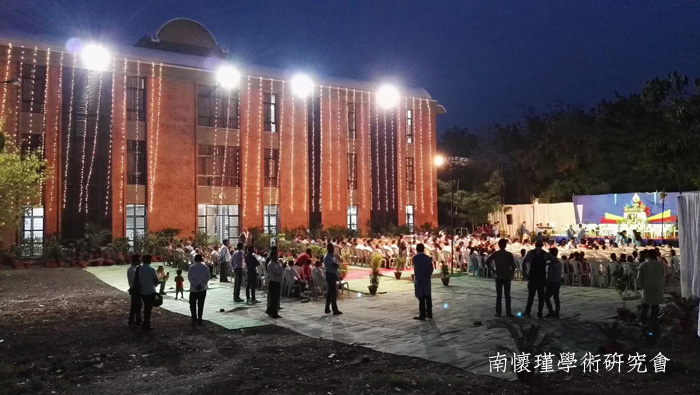
(南师及学生捐建的印度龙树学院培训楼落成典礼)
自第二次拜见南大师之后,我便开始关注并阅读其著作(英译),也与他的一些弟子谈起他老人家。从他的修行、理解与见地,我感觉他就是现代版的维摩诘居士。他认为文明已然进入一个崭新的时代,而佛陀教义的本质必能为这个时代作出贡献。我非常希望他的著作以及其前卫的精神能够走出华人的世界,尤其是进入印度,成为当前印度佛教复兴运动的一部分。我希望能够在这方面有所作为。首先,我们可以在龙树学院举办研讨会,探讨南大师对现代佛教所作的贡献与意义。
Since then I have read what I can of his teachings in English and talked to some of his disciples. From the little glimpse of his great practice, understanding and vision, he seemed a Vimalakirti of the modern world. He thought civilisation was entering into a new era, and that the Buddha’s teachings had the innate capacity to contribute to this significantly. I hope very much that his teachings and his creative spirit go beyond the Chinese speaking work and especially that they come to India and become part of the momentous revival of Buddhism that is taking place here. We hope to be able to contribute to this, starting by organising a seminar at the Nagarjuna Institute, on the significance of Master Nan’s contribution to Buddhism in the modern world.
这里还牵涉另一个原因:中印两国皆为亚洲巨子,无论是物质或是维系和平的发展,中印关系都有可能对世界产生越来越大的影响。两国透过佛法的交流与联系,必能为世界的和平有所贡献。我深信这个理念绝对不违背南大师的本怀。
There is another factor; China and India are the two greatest powers in Asia and their relationship is likely to have an increasing influence on the world, in terms both of material development and of peace. Surely the fact that they are connected through the Buddha-Dharma can be developed to contribute towards world harmony. I am sure this cannot have been far from Master Nan’s mind.
---------------------------------------------------------------------------------------------------------------------
附:
龙树学院于印度佛教复兴中的重大意义
The Nagarjuna Institute and its Significance in the Revival of Buddhism in India.
南大师非常支持我在印度的工作,而他给我的启迪亦是推动我持续这项任务的动力之一。因此,我想我必须多作一些陈述。
As Master Nan was very supportive of the work I am involved in, in India, and his inspiration is one of the factors that gives me energy to continue this work, I thought I should say a little more about it.
概况:
如上所述,现今印度新皈依的佛弟子可能多达五千万人。但实际上,皈依佛教的潜在人数可能更加可观。现阶段2.3亿的达利特种姓者对佛教持开放态度,因此假设引导得当,几乎所有达利特皆可能成为佛弟子。另外,印度约1亿的部落族群当中,也有越来越多人对佛教感兴趣。除此之外,印度超过6亿首陀罗(相等于印度一半的人口),如今亦有逐步投奔佛教的倾向。目前,这个数字虽然还不大,但一直都在稳健地增长。而且有趣的是,近期皈依佛教的一支首陀罗,竟是来自北印度的释迦族后裔。目前龙树学院就有35位释迦族学生。他们追本溯源,发现自己源自佛陀的释迦族,只是后来被印度教贬为首陀罗。言归正传,这当中的关键是,在未来50-100年之间,印度佛弟子的数量将会相当惊人。假设佛教能够以善巧的方式接引他们,那么我敢断言在未来50-100年之间,新皈依佛教的人数将成长至3亿人口,甚至是更多。佛弟子增长率越高,就意味着对印度社会、文化与政治的影响越大。这股旋风极有可能席卷全亚洲,催化亚洲佛教的复兴,同时更有如南大师所言,2500年前的历史或有可能重演,这股旋风将对新兴文明发挥重要作用。这,就是龙树学院的背景和愿景。
Situation: As I mentioned above that there could be 50 million Buddhists in India today. Actually the potential is much, much greater. Almost all the Dalit community numbering 230 million is open to the Buddha’s teaching if approached in a way they can relate to. More and more from the Tribal communities, numbering well over 100 million, are becoming interested in Buddhism. Besides them some from the traditional Sudra community - 50% of the Indian population, over 600 million today - are coming to Buddhism. Their numbers are small at present, but growing steadily. Interestingly one of the Sudra castes who have come to Buddhism recently is the Shakya caste from North India; 35 young people from the Shakya caste have studied at the Nagarjuna Institute. They trace their lineage back to the Shakya caste of the Buddha, but were downgraded in a resurgent Hinduism. The point is that the number of Buddhists in India could increase phenomenally over the next 50-100 years. If the Buddha’s teaching is available in a manner people can relate to, we can dare to think of 300 million new Buddhists, if not many more, over the next 50-100 years. The more Buddhism grows, the more it will influence Indian society, culture and politics. It will contribute to the rejuvenation of Buddhism throughout Asia and could play a significant role in the emerging new dimension of civilisation that I understand Master Nan spoke of, just as it did 2,500 years ago. This is the context and vision in which the work of the Nagarjuna Institute takes place.
影响:
我们的学生来自印度最受压迫的族群。他们初到龙树学院时,往往对人生感到无比悲观。然而经过数月的佛法实践之后。绝大多数有了巨大的蜕变,开始有了新的人生观。他们学习如何改变负面的心态,开始建立自信,相信自己能有所贡献,除了对自己的人生负责,还可以为社会谋福利。他们感受到前所未有的力量,发现自己能够更有效率的去服务他人。
Impact:
The students come from some of the most deprived backgrounds in India, and when they arrive at the Nagarjuna Institute they often pessimistic about life. After a few months of Dharma practice most feel transformed, with a new vision of life. They learn how to transform unskilful mental attitudes into skilful ones. They develop the confidence that they can do something with their lives, both for themselves and for society. They feel empowered and they can more effectively help others.
基本上,达利特种姓者本身就区分为数百个种姓,而每个种姓都对他人存有怀疑。当学生初到龙树学院时,仍然保有这样的心态。在经过数月的佛法实践之后,一切分歧便逐渐消弭。他们体验到法的平等。这个美妙的经验,就有如佛陀所言:如百川流入大海,同一咸味。
Even the Dalits are divided into hundreds of sub-castes who regard each other with suspicion. When the students arrive at Nagarjuna Institute, they often see each from that perspective. Practicing the Dharma for a few months, all the differences between them fall away and they experience the equality the Dharma brings; the Buddha described this experience beautifully when he said that one cannot tell which river a drop of sea water comes from.
他们离校后,回到了自己生长的城镇,开始将佛法分享给周遭的亲戚朋友。在历经了长达700多年的佛教晦暗期之后,龙树学院开始扮演着传扬正法的角色。佛弟子听闻了佛陀的教导之后,再辗转复诵,将正法传遍印度的每一个城镇乡村。而随着佛陀的教导,他们接收到的讯息是“力量、平等、友谊”。
After they leave, many share what they have learnt of the Dharma in their towns and villages. The Nagarjuna Institute has resulted in the Buddha’s teaching once again being heard and recited in hundreds of towns and villages throughout the length and breadth of India, after an absence of over 700 years. And with the Buddha’s teaching, comes the message of empowerment, equality and friendship.
因为佛教赋予的“力量”,我们已经有超过100名学生信心满满地走入了研究生的生涯,开始求取学士、硕士和博士学位。其中包括知名大学、佛教研究领域,甚至是学习中文。
Over 100 students have developed the confidence to pursue post-graduate studies, M. A., M. Phil., M. B. A. and Ph. D., some at very prestigious institutions, and some in Buddhist Studies, and some in Chinese Studies.
许多投入社会工作的学生,都认为是佛教实修赋予他们力量从事这些工作。其中发起的社会运动包括:和备受歧视的穆萨哈尔(捕鼠族)和粪扫族达利特孩子合作;为400名孩童开办学校;为遭受天灾影响与歧视的孩子提供宿舍;展开“提高村庄的意识”计划,打击迷信并鼓励女权意识;为残疾儿童办学校;回应印度种姓对达利特犯下的暴行;为村庄的孩子举办幼儿园和补习班;鼓励年轻人认真思考皈依佛教的意义。
Many engage in social projects, finding Buddhist practice empowers them to do so. These include: working with children the most degraded Dalit castes such as human scavengers and those from the rat- eating caste, starting schools, one of which is for disabled children, relief work in natural calamities, running hostels for children who would find it hard to get an education otherwise (Ami you may have to give a note explaining), responding to atrocities committed by Caste Hindus on Dalits, running kindergartens for children in the villages, and conducting awareness programmes in villages to counteract superstition, encourage women's empowerment, and encourage young people to think seriously about Buddhism.
下面这几位年轻学子,就是因为接受了龙树学院的佛法熏陶而有了巨大的蜕变。
These are examples of young people whose lives have been transformed by the teaching at Nagarjuna Institute.
 斯瓦蒂·宝沓(Swati Baudha)来自奥里萨邦(Odisha)嘎啦韩地区(Kalahandi)多姆(Dom)小区,是达利特最低的种姓之一,14岁丧母。她说:“自从来了龙树学院,才意识到我们生活在充满暴力的社会。我也学习到如何回馈社会,同时接触到广大的安贝卡与佛教运动。”完成学业后,斯瓦蒂加入奥里萨邦的羯陵伽之友基金会(Kalingamitra Trust),协办禅修闭关、座谈会、研讨会、提高佛弟子对佛教的认识。斯瓦蒂主修社会学,取得妇女学哲学硕士学位,目前正在孟买塔塔集团社会科学研究所(Tata Institute for Social Sciences)攻读博士学位。
斯瓦蒂·宝沓(Swati Baudha)来自奥里萨邦(Odisha)嘎啦韩地区(Kalahandi)多姆(Dom)小区,是达利特最低的种姓之一,14岁丧母。她说:“自从来了龙树学院,才意识到我们生活在充满暴力的社会。我也学习到如何回馈社会,同时接触到广大的安贝卡与佛教运动。”完成学业后,斯瓦蒂加入奥里萨邦的羯陵伽之友基金会(Kalingamitra Trust),协办禅修闭关、座谈会、研讨会、提高佛弟子对佛教的认识。斯瓦蒂主修社会学,取得妇女学哲学硕士学位,目前正在孟买塔塔集团社会科学研究所(Tata Institute for Social Sciences)攻读博士学位。
Swati Baudha comes from one of poorest places in India, the Kalahandi district of Orissa, and one of the lowest so-called Untouchable castes. Her mother died when she was 14 years old. She says that ”After coming to the Nagarjuna Institute, I realized that we live in a violent society. I also learned the tools to serve the society. I came in contact with the Buddhist movement”. Afterwards Swati became associated with the Kalingamitra Trust in Orissa, which organizes retreats, workshops, and seminars to create awareness about Buddhism. Swati graduated in Sociology and then completed her M. Phil in Women’s Studies. She is currently preparing to go to UK to study for a Ph.D.
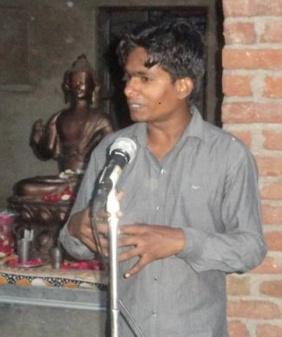 卡麦尔·菩提(Kamal Bodhi)来自拉贾斯坦邦阿尔瓦地区。他为了经济支持双亲而不得已辍学。卡麦尔说:“虽然我来到龙树学院之前也一直自诩佛弟子,但从来就不曾遵循佛陀的教导。来到这儿之后,我有了很大的改变,开始学习佛教价值观,落实慈悲的精神,学习正念与宽容。”他过去一直都在自己的家乡从事弘扬正法的活动,而目前在中国鞍山师范学院学习中文。
卡麦尔·菩提(Kamal Bodhi)来自拉贾斯坦邦阿尔瓦地区。他为了经济支持双亲而不得已辍学。卡麦尔说:“虽然我来到龙树学院之前也一直自诩佛弟子,但从来就不曾遵循佛陀的教导。来到这儿之后,我有了很大的改变,开始学习佛教价值观,落实慈悲的精神,学习正念与宽容。”他过去一直都在自己的家乡从事弘扬正法的活动,而目前在中国鞍山师范学院学习中文。
Kamal Bodhi is from Alwar, Rajasthan. He had to drop out from school to financially support his parents. Kamal says, “Before coming to the Nagarjuna Institute, I used to call myself a Buddhist, but was not following the teachings and practices. After coming here, I got transformed and learned Buddhist values such as loving kindness, compassion, mindfulness and generosity”. He has been developing Dharma activities in his state. At present Kamal is learning Chinese at Anshan Normal University, China.
 迪维雅(Divya)来自泰米尔纳德邦(Tamil Nadu),一样是出生极为贫寒的达利特种姓,属于该社区第一批有幸接受教育的女孩。迪维雅自童年开始就受尽性别与种姓歧视。她2009年成为龙树学院的学生后有感而发:“我来到龙树学院之前,对人生目标空白一片。来到这里,大家对待我的方式令我十分感动。我的自信和灵感,都是龙树学院赋予我的礼物。”迪维雅目前主要协办泰米尔邦的佛教活动,最近刚完成她的硕士学位,目前是龙树学院的教职人员。
迪维雅(Divya)来自泰米尔纳德邦(Tamil Nadu),一样是出生极为贫寒的达利特种姓,属于该社区第一批有幸接受教育的女孩。迪维雅自童年开始就受尽性别与种姓歧视。她2009年成为龙树学院的学生后有感而发:“我来到龙树学院之前,对人生目标空白一片。来到这里,大家对待我的方式令我十分感动。我的自信和灵感,都是龙树学院赋予我的礼物。”迪维雅目前主要协办泰米尔邦的佛教活动,最近刚完成她的硕士学位,目前是龙树学院的教职人员。
Divya comes from a very poor Dalit family in Tamil Nadu and is the first generation of girls in her community to get an education. She faced discrimination based on her caste and gender since her childhood. In 2009 she came to Nagarjuna Institute and says “I had no goals in my life before coming to Nagarjuna Institute. I got deeply moved with the way people treated me here. The confidence and inspiration I gained is the gift of Nagarjuna Institute”. Divya helps organize Buddhist activities in Tamil Nadu. She has completed a Masters degree in Education and is now helping us develop the teaching at Nagarjuna Institute.
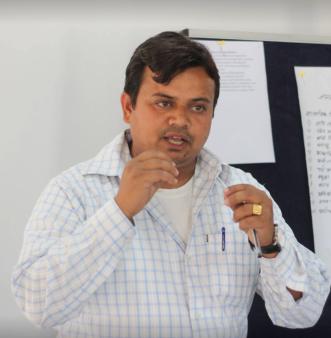 马诺·乔达摩(Manoj Gautam)来自拉贾斯坦邦巴拉特普尔(Bharatpur)雅塔夫种姓。多数雅塔夫以矿工或碎石工为生,对健康有极负面影响。马诺在不得已的情况下辍学,到德里当劳役,其父是安贝卡博士社会运动的成员。来到龙树学院之后,马诺的生活起了大变化。他说:“我本来个性好斗,但当我改变了自己愤怒的习性之后,生活开始有了方向和理想。我也逐渐建立起自信,并学会与人沟通。”马诺借助父亲的支持,设立了阿雅塔拉信托(Aryatara Trust),并且在自己生长的村庄开办了一所小学。他极为关注种姓歧视、嫁妆制度、穿戴面罩习俗、童婚等课题,同时积极举办佛教节庆活动、佛教闭关与传扬佛法。
马诺·乔达摩(Manoj Gautam)来自拉贾斯坦邦巴拉特普尔(Bharatpur)雅塔夫种姓。多数雅塔夫以矿工或碎石工为生,对健康有极负面影响。马诺在不得已的情况下辍学,到德里当劳役,其父是安贝卡博士社会运动的成员。来到龙树学院之后,马诺的生活起了大变化。他说:“我本来个性好斗,但当我改变了自己愤怒的习性之后,生活开始有了方向和理想。我也逐渐建立起自信,并学会与人沟通。”马诺借助父亲的支持,设立了阿雅塔拉信托(Aryatara Trust),并且在自己生长的村庄开办了一所小学。他极为关注种姓歧视、嫁妆制度、穿戴面罩习俗、童婚等课题,同时积极举办佛教节庆活动、佛教闭关与传扬佛法。
Manoj Gautam, from Bharatpur, Rajasthan, had to drop out from school and went to Delhi to work as a labourer. After coming to the Nagarjuna Institute, Manoj’s life changed and he says, “I was a quarrelsome person and my life got direction as I transformed my anger to live an ideal life. I also gained self confidence and learned how to communicate." Manoj set up the Aryatara Trust to run Dharma and social activities. He started a primary school in his village and focuses on issues like caste discrimination, the dowry system, the practice of wearing a veil among women, and child marriage. He organizes Buddhist festivals, and Dharma retreats to spread Buddhism.
未来:
我们还有不少经历和成就相仿的学生,而未来像这样出色的学生将逐年增多。这些孩子犹如一颗颗的小石子,每一颗投入正法之流的小石子,将激起一波波正法的涟漪,散往印度各方。龙树学院希望竭尽所能帮助饱受社会压迫的孩子,将他们培育成法的种子,赋予他们力量,好让他们将佛陀的正法带回正法的故乡。
The Future:
There are many, many other students like them, and over the next few years there will be many more. Each one of them is like a stone dropped into a pool, the ripples they create spreading far and wide. We want to do as much as we can to empower young people like these to bring Buddhism back to India and help the most socially deprived members of society.
龙树学院:
我们希望尽快将住宿培训人数从120人增至300人,因此急需增设新宿舍和教学设施。(有关详情,请参阅网站http://www.nagaloka.org/)
The Nagarjuna Institute:
We want to increase the number of residential students at from 120 to 300 as soon as possible, requiring new residential and classroom facilities (see website for more information).
在南大师的鼓励下,我们正积极引进中文学科,希望于2018年7月份开始,把中文纳入龙树学院学士学位的副修科目。这段期间,学生必须参与“汉语水平考试”教程。我们会鼓励那些通过考试,想要继续进修中文的学生,分别前往与龙树学院有联谊的中国大陆或是台湾各大院校、佛学院继续进修。
Encouraged by Master Nan, we are experimenting with making Chinese studies an optional subject as part of the BA degree in Buddhist Studies at the Nagarjuna Institute, from the coming academic year starting in July 2018. During this period students will study for the Hanyu Shuiping Kaoshi (Chinese Proficiency Tests) and afterwards those who want to pursue their studies further will be encouraged to stay with educational and Buddhist institutions in China and Taiwan who are in contact with the Nagarjuna Institute.
龙世校友会:
龙世校友会透过区域及国际禅修营、研讨会等活动来协调、支持和引导(各州)校友。在未来五年,校友会成员将增至2000名,形成一个印度法行者网络。彼此的联谊,可以让他们更有凝聚力,让他们重新体验超越(种姓与区域)的力量与本质,同时建立一个以法为皈依的新印度愿景。
The Nagaloka Alumni Association:
this has been started to coordinate, support and guide the alumni through national and regional Dharma retreats, and conferences. In five years time there could be 2,000 alumni making a sangha or all-India network of Dharma practitioners. Coming together enables them to re-experience and strength the transcendent (over caste and region) nature of the alumni community, and its vision of a new India influenced by the Dharma.
阿育王正法使者计划:
因受到“行禅中的佛陀”启发,我们正积极培训校友以更具系统与结构的方式,深入各个乡镇村落弘扬佛法。希望藉由这个途径在未来数年,让印度数百甚至是数千个乡镇村落,都成为正信的佛化社区。为了让校友能够更具效益去因应可怕的社会问题、教导正法,我们亦为这些成员提供进一步的特训。另外,我们还希望协助他们从商,让他们不但可以自给自足,还能够让区域性的弘法活动(在经济上)得以永续。龙树学院的远大目标在于协助印度佛教之复兴,但我们仅能仰赖一切可取得的资源。
Ashoka Dharmaduta Project:
Inspired by the Walking Buddha, we are training our alumni to teach the Dharma in villages and towns throughout India in a systematic and structured way. In this way we hope to establish confident communities of Dharma practitioners in hundreds of villages and towns over the next few years. We give further training in social work so that they can respond more effectively to the terrible social problems people face in the places where they teach the Dharma. We are also helping them establish businesses, not only to support themselves, but also their local Dharma work. The scope for the Nagarjuna Institute to help revive Buddhism in India, is enormous, and just depends on the resources available.
我们非常欢迎南大师的弟子参访印度,亲眼目睹这尊各位出资塑建的“行禅中的佛陀”;这尊启迪龙树学生学习并传扬正法的施无畏大佛。因为您的支持,这尊独特的佛像得以落成;因您的参与,亦更积极地转动了印度佛教复兴的法轮。
We welcome Master Nan’s disciples to visit us in India and see for themselves the unique Walking Buddha he helped to make possible, which inspires our students to practice and spread the Dharma. We hope they will see for themselves something of the work of the revival of Buddhism in India, which he was so supportive of.
欲知更多的讯息,请参阅我们的网站。谢谢!
For more information see website.(http://www.nagaloka.org/)Thanks!
